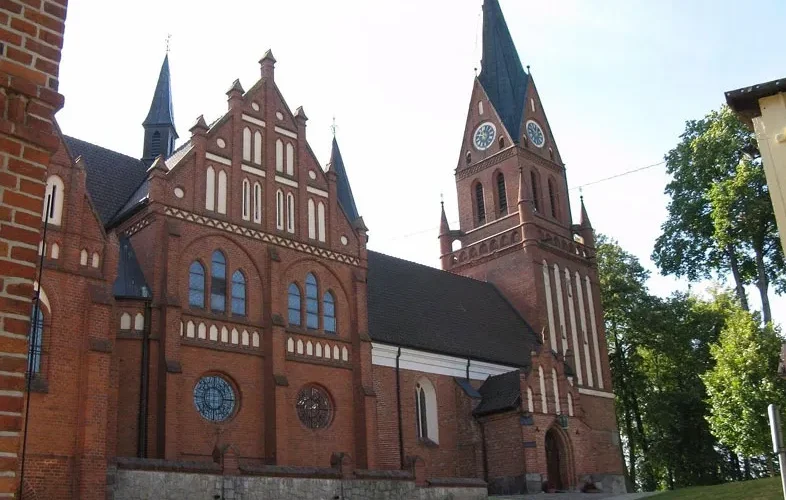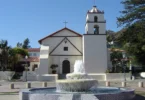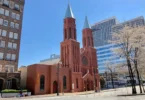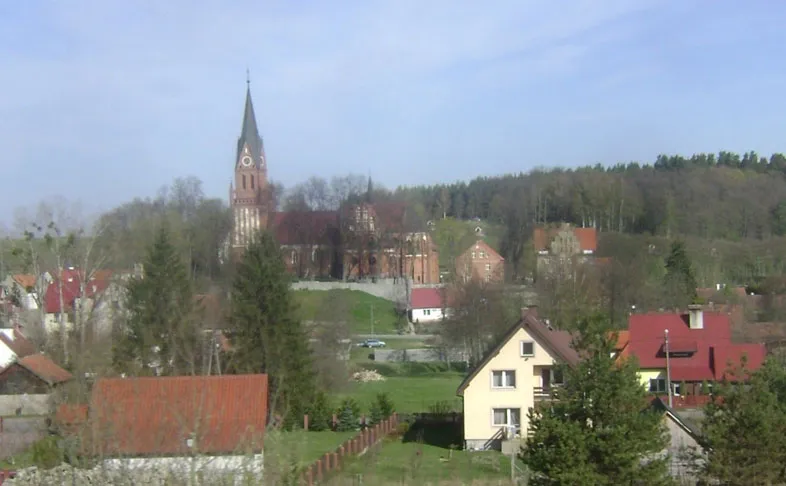
Introduction
Basilica of the Nativity of the Blessed Virgin Mary in Gietrzwałd also known as Sanctuary of Our Lady of Gietrzwałd, Poland. The first church was built shortly after the location of the village. Before 1500, a new brick and stone church was built or expanded. A simple aisle building in the Gothic style has been partially preserved from this period to this day. On March 31, 1500, the church was consecrated, giving it the invocation of the Nativity of the Blessed Virgin Mary.
The Sanctuary of Our Lady of Gietrzwałd, Poland of Virgin Mary, Gietrzwałd and the Stations of the Cross located near the forest. There is also a rosary alley leading to the associated spring, the Chapel of the apparitions and the picture of Virgin Mary. This chapel is the most famous of the local chapels which are a distinctive element of the Warmian landscape.
It was rebuilt many times. In 1970, Pope Paul VI gave the church in Gietrzwałd the title of a minor basilica. The facility is located on a hill in the center of the village and is fenced with a stone wall. In the north-eastern part there is an alley leading to the spring, in the west there is a pilgrim’s house and a rectory with the chapel of St. Joseph.
The villagers are mostly followers of the Roman Catholic Church. There is a Marian sanctuary in this town. The sanctuary has been under the care of regular Lateran canons since 1945. Gietrzwałd became famous in 1877, when from June 27 to September 16, on a church maple, two girls: Barbara Samulowska (now her beatification process is underway) and Justyna Szafryńska, were to appear the Mother of God.
The apparition was called the apparition in Gietrzwałd. Both girls came from poor families. Mary was to speak to them in Polish, which caused a stir as Polish was forbidden in Prussia at that time.
This fact strengthened the Polish movement in Warmia. From the time of the apparition to the Marian sanctuary in Gietrzwałd every year, numerous crowds of pilgrims (a total of up to a million a year) come every year. The vicar of the Gietrzwałd church was for several years Fr. Wacław Osiński, president of the Union of Poles in Germany for the East Prussia district.
Gietrzwałd
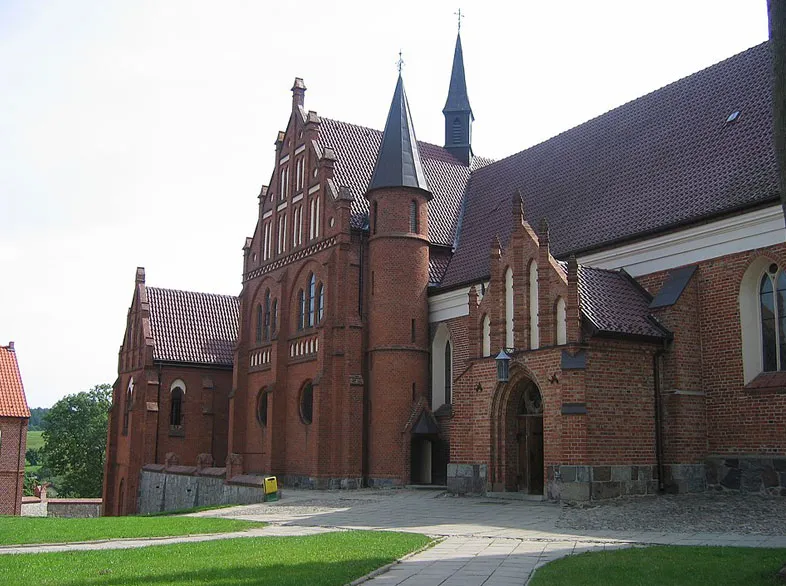
Gietrzwałd is a village in northeastern Poland located in Warmia, in the Warmian-Masurian Voivodeship, near Olsztyn. Gietrzwałd is the capital of Gmina Gietrzwałd. Gietrzwałd is a popular Roman Catholic pilgrimage destination.
Gietrzwałd was founded in 1352 within the Archdiocese of Warmia, then within the dominions of the Teutonic Order, by one Dietrich or Ditter, who named it Dietrichswald. In the 15th century, Gietrzwałd was destroyed during the Thirteen Years’ War between Poland and the Teutonic Knights. The village was invaded by the Teutonic army under the command of Georg von Schlieben.
In the middle of the 16th century, the settlement was not developing, although there was a school and an inn (Jerzy Kunig had been the owner of the inn since 1645). In 1772 the village was annexed by the Kingdom of Prussia in the First Partition of Poland, and subsequently the local Polish population was subjected to Germanisation. In 1783, there were 57 houses in Gietrzwałd. In 1807, the village was attacked and plundered by the French army in the Napoleonic wars.
History of Sanctuary of Our Lady of Gietrzwałd, Poland
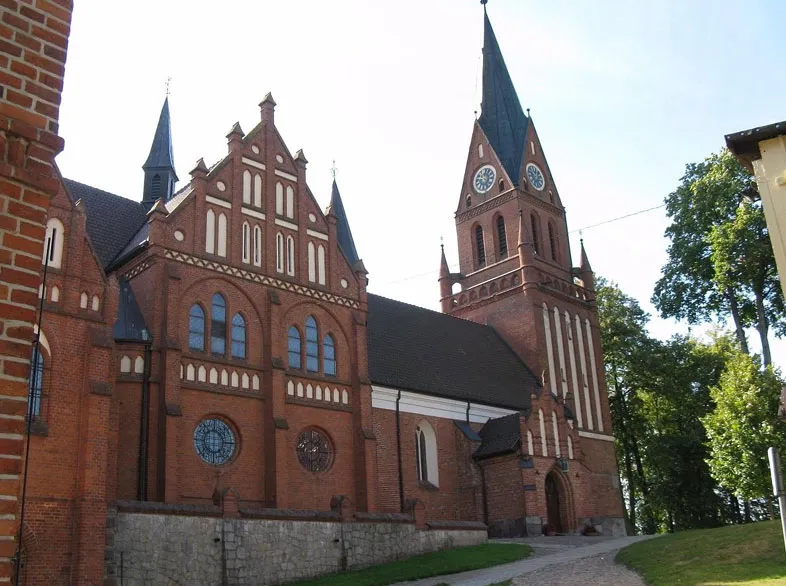
The Sanctuary of Our Lady of Gietrzwałd, Poland – The 145th anniversary of the Marian apparitions in Gietrzwald falls on June 27, 2022. Although not as well-known as Fatima, this shrine is a major pilgrimage destination in Poland, which prior to the pandemic, was visited by about one million of people every year. Poland’s President, Andrzej Duda came to pray there five years ago.
Today, when the peace of the world, the peace of families and of whole societies is in danger because of human sin we should direct our gaze towards the Virgin Mary.
Gietrzwald, formerly called Dietrichswalde, lies in the district of Warmia in northern Poland, which at the time of the apparitions was annexed to the German Empire. It was surrounded by Prussian Lutherans, but the majority of people there were Catholic and spoke the local dialect similar to the Polish language. Severe restrictions, including the ban on Polish language in schools and public offices, were enacted under Bismarck’s Kulturkampf regime. Catholic priests and religious congregations, except those which were actively involved in social work, were removed from the district.
Gietrzwałd is situated halfway between Ostróda and Olsztyn, on the edge of southern Warmia, surrounded by small mounds on the Giłwa River, the right tributary of the Pasłęka. The settlement charter was issued on May 19, 1352 by the Warmia Cathedral Chapter.
At the beginning, a wooden chapel was erected on the hill, gently sloping towards the river. The parish was probably established at the same time. The first known parish priest was Jan Sternchen (1405-1409). During the Polish-Teutonic war in 1410-1414, the village and the chapel were destroyed. In the 15th century, a single-nave Gothic church was erected on a stone foundation. It was consecrated on March 31, 1500, under the invocation of the Nativity of the Blessed Virgin Mary, by bishop Jan Wilde, a suffragan of Warmia.
The church (The Sanctuary of Our Lady of Gietrzwałd, Poland) was rebuilt many times. The first major renovation and adaptation of the church to the Renaissance style took place at the end of the 16th century. Then, during the Baroque period, the temple was equipped with new altars. On June 11, 1790, Bishop Ignacy Krasicki gave the temple two new titles: Saint John the Evangelist and Saint Apostles Peter and Paul. In the nineteenth century, Fr. parish priest Józef Jordan (1863-1869) led to the expansion of the church, strengthened the foundations and walls.
The Sanctuary of Our Lady of Gietrzwałd, Poland became famous thanks to the Apparitions of Our Lady, which lasted from June 27 to September 16, 1877. The main visionaries were: thirteen-year-old Justyna Szafryńska and twelve-year-old Barbara Samulowska. Both came from poor Polish families. Our Lady spoke to them in Polish, as emphasized by Fr. Franciszek Hipler, “in the language they speak in Poland”. Mother of God, at the request of the girls: Who are you? She replied: “I am the Blessed Virgin Mary, Immaculate Conception.” When asked what do you ask, Mother of God? the answer was: “I wish you to pray the rosary every day!”
The temple took its present shape immediately after the apparitions, when the parish priest was Fr. Augustyn Weichsel (1869-1909). In the years 1878-1884, under the direction of the architect Arnold Güldenpfennig, the church was enlarged so as to connect it with the new, neo-Gothic part without disturbing the Gothic part and create a harmonious whole. A transverse nave with galleries and a chancel with a crypt were added, giving the church the shape of a Roman cross. The upper, wooden part of the tower was demolished and a brick one with a neo-Gothic top was erected. The roof of the church was covered with tiles and the tower with sheet metal.
On August 13, 1945, the Order of Regular Lateran Canons was entrusted with the care of the Gietrzwałd Sanctuary.
In the years 1966-1968, the old, damaged fence was demolished and a new stone wall with forged metal spans was built, granite stairs and a stone and cement bypass around the church were built. Before the celebration of the 100th anniversary of the apparitions of Our Lady, the architecture and interior of the church were renovated, a new marble floor was installed and the polychrome was restored. Fifteen new rosary chapels were built by the sculptor Julian Kasprzycki from Myślenice, designed by the architect Sylwester Kwiatkowski from Białystok, by the hornbeam alley leading to the spring.
By virtue of the bull of Pope Paul VI of February 2, 1970, the church in Gietrzwałd was awarded the title of a minor basilica.
The celebration of the 100th anniversary of the apparitions in 1977 showed the need to create a pilgrimage house in Gietrzwałd. The then prior of the religious house in Gietrzwałd, Fr. Franciszek Martuszewski CRL. In difficult times, with the obstacles to obtain a building permit and purchase of building materials, and the difficult financial situation of the sanctuary, the construction took over 10 years. In 1989, the first pilgrims used the services of the new pilgrimage house.
On October 14, 2003, the Friends of the Sanctuary of Our Lady of Gietrzwałd Foundation was established. Its aim is to conduct a religious, cultural and social, charitable and caring work supporting the Sanctuary. In February 2010, the Foundation opened a Leisure and Training Center with 50 beds and a conference room in Gietrzwałd.
On February 2, 2005, in the Gietrzwałd basilica, Fr. Archbishop Edmund Piszcz, Metropolitan of Warmia, opened the beatification process of the visionary sister Stanisława Barbara Samulowska (1865-1950) from the Congregation of the Sisters of Mercy of St. Vincent de Paul.
On June 27, 2007, Fr. Archbishop Wojciech Ziemba consecrated the Way of the Cross in Gietrzwałd, the chapels of which were erected on the Gietrzwałd meadows, designed by Marcin Dutko from Warsaw, and the sculptures by Jan Stępkowski from Strzegowo.
In April 2012, a general renovation of the ground-floor part of the pilgrim’s house was carried out, where there are: a reception, two dining rooms, a dining point, a new kitchen, toilets, also for the disabled. The rooms were renovated with new furniture.
Architecture of Sanctuary of Our Lady of Gietrzwałd, Poland
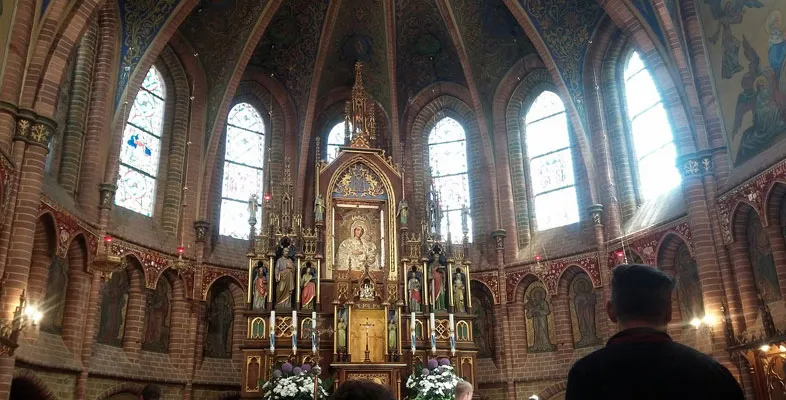
The Sanctuary of Our Lady of Gietrzwałd, Poland – Soon after the location, a church was built in Gietrzwałd. We do not know if it was a wooden chapel or the same church that was consecrated a hundred years later. This church is mentioned in the preserved list of parishes from the end of the 15th century. It could have been a single-space, wooden structure on a high foundation made of fieldstones joined with a sand-lime mortar. From the west, there is a bell tower and one altar in the middle. Inside this temple, there was a Gothic sculpture of Pieta from 1425 that has survived to this day, and perhaps a granite baptismal font, which currently functions as a stoup.
We do not know the name of the first parish priest. The preserved archives show one of the first, which was Jan Sternchen in the years 1405-1409. Before him, the functions of parish priests could be performed by patrons from the chapter, or missionaries of one of the mendicant orders. This first church could have been destroyed during the war of 1410-1414. Before 1500 there was an extension, or perhaps the construction of a new stone and brick church, which is partially preserved to this day as a simple hall structure in the folk Gothic style. The church consisted of a rectangular nave with adjoining tower, sacristy and porch.
The interior was covered with a wooden ceiling, the sloping roof with shingles or tiles. Only wealthy churches could afford to pay a master who knew the constitution of stone vaults. adjoined: tower, sacristy and porch. The interior was covered with a wooden ceiling, the sloping roof with shingles or tiles. Only wealthy churches could afford to pay a master who knew the constitution of stone vaults. adjoined: tower, sacristy and porch. The interior was covered with a wooden ceiling, the sloping roof with shingles or tiles. Only wealthy churches could afford to pay a master who knew the constitution of stone vaults.
The consecration of this Church took place on March 31, 1500. The consecrator was Bishop Jan Wilde, the first suffragan bishop of Warmia, an Augustinian monk. the church received the invocation of the Nativity of the Blessed Virgin Mary, and shortly thereafter the second title of St. John the Evangelist mentioned in the acts of 1609 and 1721. There are four ogival window openings in the side walls of the nave. The eastern wall also had two ogival windows, and two round ones above. With time, the lower windows were partially walled up, and two side altars were placed on them.
The only architectural decorations of the church were eastern and western stepped gables, a sloping saddle roof and a tower built on a square plan, in the lower part made of a solid stone wall, above it was wooden. From this tower, at the beginning of the 16th century, people called Ave Maria twice a day. There was also a baptismal chapel, but it is not known when it was erected, mentioned in the 16th century.
There was also a foundation plaque with an inscription about the consecration of the church and altars, hanging in the 18th century, not preserved today. In this church there was also – as everywhere in Gothic churches – a wall ciborium. Based on archival records and autopsies, it can be concluded that at the end of the 16th century, the church underwent a major renovation, which was also aimed at modernizing the interior. The modernization consisted in giving the ogival window openings a fashionable, Renaissance rectangular shape by partially bricking them up.
From that time, the date 1592 remained on the then eastern wall of the church, mentioned in the files as early as the 19th century, no longer existing today, probably wasted during the expansion of the church in the 19th century. Inside there were also old, small organs made by Abraham Kanin, the then organist from Gietrzwałd, which were destroyed during the Swedish wars. From the seventeenth and nineteenth century visitation records, we learn even sensational information: in the main altar at that time were the relics of St. Luke the Evangelist, and one of the bells made in the workshops of the order.
From that time, the date 1592 remained on the then eastern wall of the church, mentioned in the files as early as the 19th century, no longer existing today, probably wasted during the expansion of the church in the 19th century. Inside there were also old, small organs made by Abraham Kanin, the then organist from Gietrzwałd, which were destroyed during the Swedish wars. From the seventeenth and nineteenth century visitation records, we learn even sensational information: in the main altar at that time were the relics of St. Luke the Evangelist, and one of the bells made in the workshops of the order.
From that time, the date 1592 remained on the then eastern wall of the church, mentioned in the files as early as the 19th century, no longer existing today, probably wasted during the expansion of the church in the 19th century. Inside there were also old, small organs made by Abraham Kanin, the then organist from Gietrzwałd, which were destroyed during the Swedish wars.
From the seventeenth and nineteenth century visitation records, we learn even sensational information: in the main altar at that time were the relics of St. Luke the Evangelist, and one of the bells made in the workshops of the order. which were destroyed during the Swedish wars.
From the visitation files of the 17th and 19th centuries, we learn even sensational information: the main altar at that time contained the relics of St. Luke the Evangelist, and one of the bells made in the workshops of the order which were destroyed during the Swedish wars. From the visitation files of the 17th and 19th centuries, we learn even sensational information: the main altar at that time contained the relics of St. Luke the Evangelist, and one of the bells made in the workshops of the order.
Marian Apparition - Our Lady of Gietrzwałd
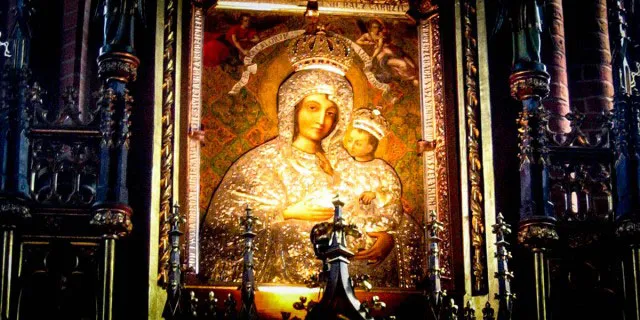
At Gietrzwald in 1877, 40 years before Fatima and 19 years after Lourdes, between June 27 and September 16, Our Lady visited two young girls, thirteen-year-old Justyna Szafryńska and twelve-year-old Barbara Samulowska.
It is particularly noteworthy that the Mother of God appeared to these visionaries over 160 times, which makes it more relevant to consider them carefully. By comparison, Bernadette Soubirous witnessed the Blessed Mother 18 times in Lourdes, Lúcia dos Santos and her cousins Francisco and Jacinta Marto saw her 6 times at Fátima, while Maximin Giraud and Mélanie Calvat had a vision of Our Lady only once at La Salette.
The Blessed Virgin Mary, despite numerous obstacles put in the way by Prussian and Russian authorities, attracted one million pilgrims to Gietrzwald over the period 1877-1880, which at the time accounted for as much as 10 per cent of the Polish population under foreign occupation. It is as if about 33.5 million Americans or 2.5 million Australians, trying to overcome Covid restrictions, within three years made a pilgrimage to Fatima.
On June 6, 1877, Blessed Pope Pius IX, at an audience, while pointing to the Scripture “Jesus said to Peter, `Put your sword into its scabbard`.” (John 18:11) appealed to Polish pilgrims to strive for independence in a peaceful way through prayer, because the greatest enemy is sin. His words proved prophetic since in three weeks time God Himself intervened.
Bear in mind that two and a half years later, the parish priest Fr. August Weichsel wrote “the fruits of the apparitions are extraordinary. Millions [of Poles] are saying the Rosary which results in affirming their Catholic beliefs, and also a great number of drunks have been saved from eternal damnation and temporal punishment.”
Fr. Doctor Krzysztof Bielawny draws attention to the rapid demographic upsurge, followed by the increase of vocations to the priesthood and consecrated life. Over the next 40 years the Polish population nearly doubled which, in his opinion, is partly a corollary of the Marian apparitions. Moreover, they pushed aside the thought of an armed insurrection and focused instead combating the most insidious danger: sin.
If anyone says that sin it is just his or her private affair, they are dangerously deluding themselves. Saint John Paul II clearly stated in his Apostolic Exhortation – Reconciliation and Penance “…one can speak of a communion of sin, whereby a soul that lowers itself through sin drags down with itself the church and, in some way, the whole world. In other words, there is no sin, not even the most intimate and secret one, the most strictly individual one, that exclusively concerns the person committing it.”
“When we look at our families, our cities, our country, when we look at what is happening in Ukraine, the root cause of all that is sin, our individual sins and those of other people,” said Fr. Krzysztof Flis OFM Conv.
Archbishop Sviatoslav Shevchuk of the Ukrainian Greek Catholic Church has recently slammed the practice of abortion, claiming that it has killed ten times more people than his country’s ongoing war with pro-Russian rebels. By the onset of war, every year in this country two million children were brutally robbed of the fundamental right to live. Another abomination to the Lord is a large scale practice of surrogacy, with its center in Kiev.
No sooner did the Holy Father, Pius IX learnt about the apparitions than he stated “Now the Poles can together with Our Lady’s cousin Elizabeth exclaim triumphantly ‘And how does this happen to me, that the mother of my Lord should come to me?’ (Luke 1:43).”
History of Our Lady of Gietrzwałd
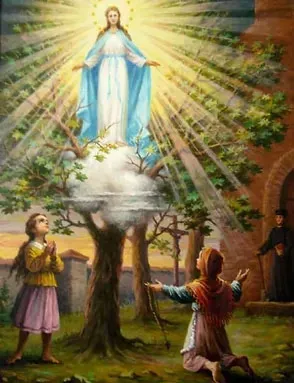
On June 30, 1877, upon the request of the parish priest Fr. Augustyn Weichsel, one of the visionaries, Justyna Szafryńka asked Our Lady “What do you want?” The reply she received was, “I want you to pray the Rosary daily.” The Blessed Mother at her last visit, on September 16, made her final words reflect her opening words: “Pray the Rosary fervently,” thus providing a comprehensive framework for the apparitions.
On August 1, Barbara asked the Virgin Mother: “Whether the orphaned parishes will receive the priests soon?” – The Holy Mother answered: “If people pray zealously, at that time the Church will not be persecuted, and the orphaned parishes will receive priests!”
About 20% fewer candidates for the Catholic priesthood enrolled in Poland’s seminaries in 2021, compared to the previous year. There were 47 fewer seminarians in diocesan seminaries and 38 fewer candidates for religious orders, said Fr. Piotr Kot, chairman of the Conference of Rectors of Major Seminaries.
Going back to the past, on September 8, 1988, a record high number, forty-two young candidates for priesthood in the Order of Friars Minor Conventual, professed their first vows while currently there are only eight of them preparing for this religious ceremony. The shortfall in the number of candidates for the priesthood is getting more and more evident, but the Virgin Mary of Gietrzwald tells clearly how to handle this crisis.
12 August – When the parish priest told the children to pray for the conversion of drunks, then the Mother of God sighed heavily and said loudly “They will be punished.”
As reported by the State Agency for the Prevention of Alcohol-Related Problems (PARPA) Poland had an annual consumption per person of 9.78 liters of pure alcohol in 2019. There has been a steady increase of average alcohol consumption since the 1990s. In 1993, the average annual consumption of pure alcohol per capita was approximately 6.52 liters.
“God does not punish us for our sins.” is the mantra embedded deep within the psyche of some Westerners. How many times have I heard people say: “I am allowed to sin because the Merciful God will always forgive me and nothing bad is going to happen to me.” Apart from Jesus and Mary, all of Adam’s descendants deserve punishment, for we have all sinned personally.
Sadly, hundreds of thousands of people, especially young women, took to the streets in October 2020, after Poland’s constitutional court imposed a near-total ban on abortion. Adding insult to injury, according to Fr. Bielawny, in the years 1920 – 2020, over 33.5 million of children were killed due to abortion in Poland, whose innocent blood is crying out to God for justice.
It is pitiful and disgraceful – even though one should not be surprised, that those who are shouting longest and loudest about the horrors of the war in Ukraine in the mainstream media, at the same time treat the unborn with disdain and hatred by supporting unlimited right to abortion.
On September 14, during the apparition Justyna asked: “If a certain Lutheran will be converted?” She heard this answer, “He should come here and learn how to say the Rosary.”
Almost three million people have entered Poland from war-torn Ukraine so far, predominantly baptized in the Eastern-Orthodox Church, religiously indifferent, though there are some Muslim refugees. It can be assumed that a significant part of them will choose to settle long term in this host member of the European Union. I wonder whether Our Lady may expect devout Catholics to bring them back to the fold of the one, true, holy Catholic Church. If Saint Andrew Bobola were alive today, he might be up to his neck in evangelizing.
Blessed Honorat Hozmiński (1829-1916), picking up the national thread of the Gietrzwald apparitions, states: “Today, as Divine Mercy has swept over the Polish nation, the Virgin Mary comes at the most difficult time.”
At the coronation of Gietrzwald Shrine, which took place in September 1967, the Blessed Primate of Poland, Cardinal Stefan Wyszynski, stated: “Faith in God and veneration for the Virgin Mary allowed us to endure the period of the indoctrination of Protestantism and the sinister Kulturkampf.”
Saint John Paul II, referring to the words “Don’t be sad, I will always be next to you,” used by the Mother of God on September 8, 1877, said “These words, uttered with maternal love, became the source of consolation and hope for all those who had experienced sadness during different individual, family and national trials. Finally uttered as a reminder of the power of the rosary prayer and a call to spiritual renewal, they contributed to the revival of the religious spirit not only in the district of Warmia but throughout Poland.”
The powerful message of Gietrzwald conveyed to us encapsulates four main ideas: fervent prayer of the rosary, moral life according to God’s requirements, a call for sobriety and a warning that sin entails punishment.
Some people tend to forget that the Mother of God is neither a good friend nor an eminent politician designed to be listened to or not. When Virgin Mary comes down out of Heaven all her subjects owe obedience to Her, which applies in particular to the Poles whose country was specially chosen by God.
“Who knows? God may again repent and turn from his blazing wrath, so that we will not perish. When God saw by their actions how they turned from their evil way, he repented of the evil he had threatened to do to them; he did not carry it out.” (Jon 3: 9-10)
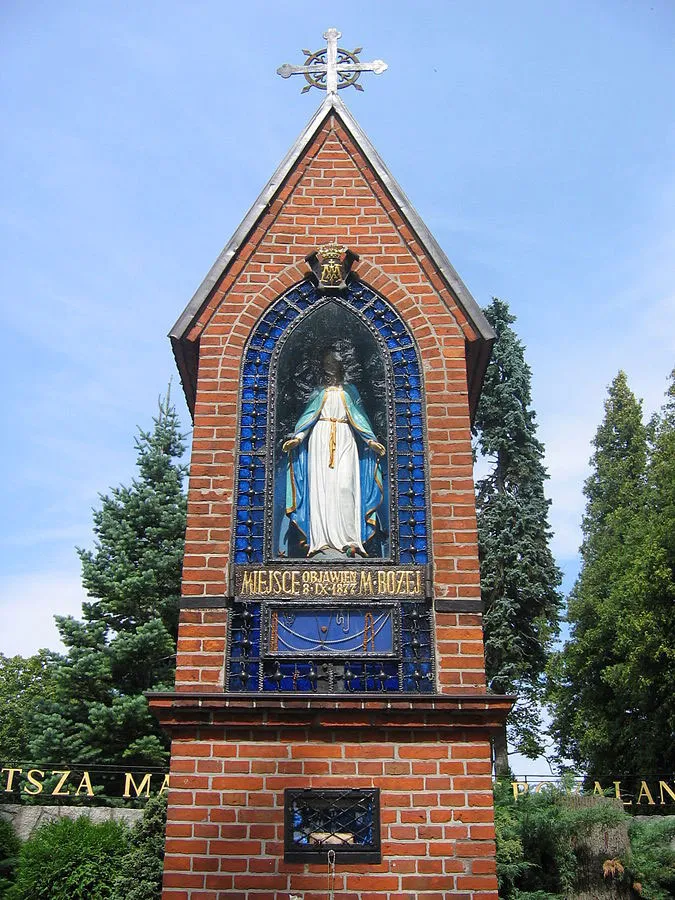
Apparitions
Gietrzwald – it is a village in the North-East part of Poland, in Masurian-Warmia region, 20 km from the town Olsztyn. In the time, when the apparitions took place, Poland was partitioned among 3 countries and did not exist on the map of the world (1795 – 1918). In Masurian-Warmia region, the Polish people were forced to speak German. The Holy Mother, who appeared to two young girls – to Justyna Szafryriska and Barbara Samulowska. came with a message of conversion. penance for the sins and She gave a great hope to the distressed people. She said messages in Polish language – what cheered the Polish people very much in the period, when Poland did not exist as a country.
The Apparition on 27 June 1sn- the first one
It took place on Wednesday on 27 June 1877, in the moment, when Justyna Szafrynska was coming back from the church together with her mother, after the exam from Catechism which she passed. This exam allowed her to receive the Rrst Holy Communion. It was the evening and the bell from the church tower rang for the Angelus. Justyna noticed the Holy Mother between the two withered boughs. The Most Holy Mary had the long hairs. After a moment, the Child Jesus descended from Heaven in white-yellow clothing. Both go to Heaven. The Child Jesus is on the left side of the Holy Mother.
The Apparition on 28 June 1877
It took place on Thursday, on 28 June 1877. This time both girls: Justyna Szafryr’iska and Barbara Samulowska saw ‘The Beautiful lady”.
The Holy Mother appeared above the maple-tree, which was near the church. The Most Holy Mary was sitting on a throne with the Child Jesus and was surrounded by the Angels. The Child Jesus held an brilliant ball with a small cross at the top. The Holy Mother was crowned by the Angels.
The Apparition on Saturday, 30 June 1877
justyna asked: “What You require Holy Mother”? and she heard the answer: I require, so that you pray Rosary every day!”. The apparition on Sunday, 1 July 1877
On this day, the children from the parish in Gietrzwald received their First Holy Communion. Justyna ask during the prayer of Rosary under the maple-tree “Who are You?” and the Holy Mother answered: I am The Most Holy Virgin Mary Immaculately Conceived!”
The Apparition on 3 July 1877
The girls asked the Holy Mother ‘Whether the sick people who come here will be healed?” The Holy Mother answered: “The miracle will happen, and after that the sick people will be healed”, and later said: “Let the sick people pray Rosary”.
The Apparition on 28 July 1877
On the question what it means if somebody swears falsely. The Holy Mother answered: “Such person is not deserving to go to Heaven, such person is induced to do it by Satan”.
The Apparition on 1st August 1877
Barbara asked: Whether the orphaned parishes will receive the priests soon?” – The Holy Mother answered: If people pray zealously. at the time the Church will not be persecute and the orphaned parishes will receive the priests!”
The Apparition on 8 September 1877
On 8 September 1877,about seven o’clock in the evening the Holy Mother blessed the spring and said the words: “Now the sick people can take this water for their healing”.
The Apparition on 16 September1877 – The Last One
On 16 September 1877 about five o’clock in the evening the Holy Mother blessed, at the beginning her own figure in the small chapel, and after that She blessed all people who asked for it and all people. At the end, She said: “PRAY ROSARY ZEALOUSLY”
After the Apparitions
On 10 September 1967 – The Primate of Poland, Cardinal Stefan Wyszyrski, crowned the painting of the Holy Mother. On the 2 February 1970 Pope Paul VI granted to the church in Gietrzwald the title and dignity of the Basilica Minor. “These apparitions of the Holy Mother are fully approved by the Holy See in 1977.”
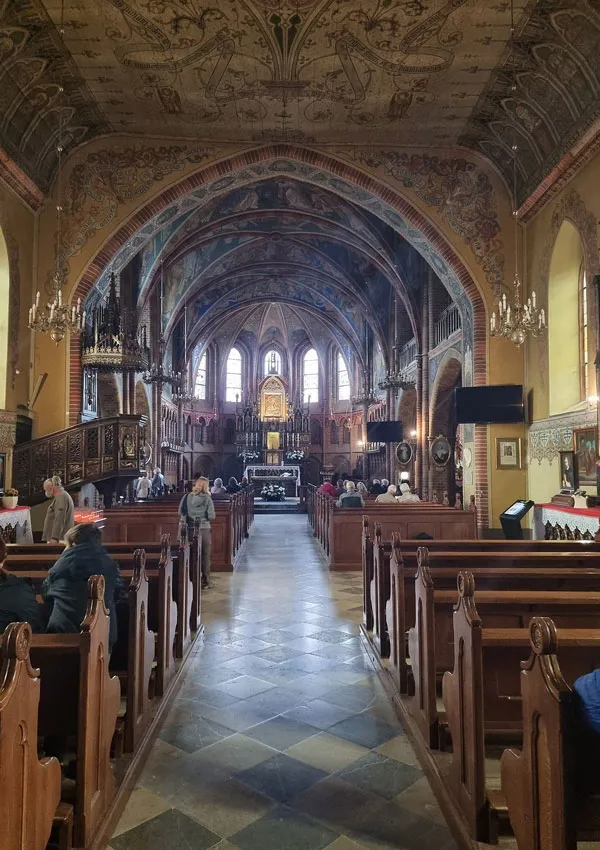
Feast Day - 8th September
Annual Feast Day of Our Lady of Gietrzwald held on 8th September.
Considered the Ermland Lourdes (Diocese of Warmia) already in the past century, Gietrzwald goes back to the Middle Ages (founded in 5/19/1352). The patronal feast since 1500 is of Mary’s birth (September 8).
Mass Time
Weekdays
- 7:00 am
- 12:00 (Noon)
- 6:00 pm
Sundays
- 7:00 am
- 9:00 am
- 11:00 am
- 4:00 pm
- 6:00 pm
Contact Info
Sanctuary of Our Lady Gietrzwałd,
Kościelna 4, 11-036 Gietrzwałd, Poland
Phone No.
Tel : +48 89 512 31 02
Accommodations
How to reach the Sanctuary
Gryźliny Airport, Poland is the nearby airport to the Sanctuary.
Biessellen Train Station in Podlejki, Poland is the nearby Train Station to the Sanctuary.

